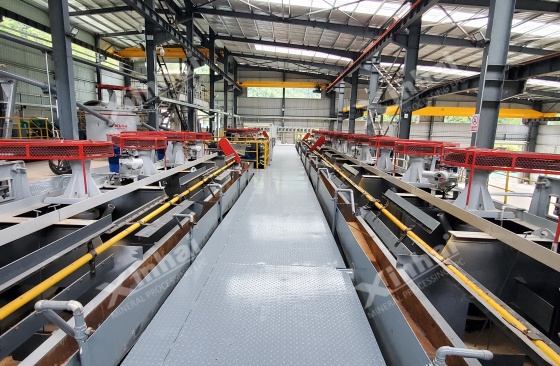If you want to know more information (such as product/process price, etc.), please contact us 24-hour telephone
Phosphate ore is the primary raw material for the production of phosphate fertilizer. With the increasing demand for phosphate fertilizer, the beneficiation of phosphate ore has attracted growing attention. Collophanite constitutes a significant portion of phosphate ore, and its main gangue minerals are quartz and dolomite. Due to the similar floatability and fine dissemination size of dolomite and collophanite, their separation is challenging. To improve the grade of phosphate concentrate, the following is a brief introduction to the separation methods of collophanite and dolomite:
Flotation is a common method for collophanite beneficiation. This technique uses a pH regulator (acid or alkali), along with collectors and depressants, to achieve the selective separation of collophanite from dolomite. Common flotation methods include:
Direct Flotation: Suitable for siliceous phosphate ore and sedimentary-metamorphic siliceous-calcareous apatite. Under alkaline conditions, a fatty acid collector is used to float the phosphate minerals, leaving dolomite in the slurry.
Reverse Flotation: Suitable for calcareous phosphate ore, especially those with high dolomite content. Under acidic conditions, fatty acid collectors are used to float dolomite, while collophanite remains in the slurry.
Direct–Reverse Flotation: Suitable for complex collophanite ores. First, direct flotation is used to float the phosphate minerals, followed by reverse flotation to remove dolomite.
Reverse–Direct Flotation: Applicable to ores where dolomite and siliceous minerals coexist closely. First, reverse flotation removes dolomite, followed by direct flotation to recover phosphate minerals.
Double Reverse Flotation: Used for low-grade phosphate ores. Initially, sulfuric acid or phosphoric acid is used to depress phosphate minerals. Then, fatty acid collectors float out dolomite. A second reverse flotation is used to remove siliceous gangue minerals.

This method is applicable to coarsely grained collophanite with a particle size greater than 0.5 mm. The separation is based on the difference in specific gravity between minerals. Common equipment includes shaking tables and spiral chutes.
This method is suitable for weathered phosphate rock or ores with high clay content. Physical friction and water flow are used to remove surface mud and impurities, thereby improving ore purity.
This method is applicable to phosphate ores with high phosphate content. Carbonate minerals are decomposed through high-temperature roasting, forming calcium oxide and magnesium oxide. These are then digested with water to produce calcium hydroxide and magnesium hydroxide, which are removed via staged separation, enriching the phosphate minerals.
These are the main methods for separating collophanite from dolomite. Among them, flotation is the most widely used and versatile technique. Xinhai Mining has over 30 years of experience in the mineral processing industry, having undertaken numerous beneficiation projects and accumulated extensive expertise. If you have any mineral processing needs, please feel free to contact us!